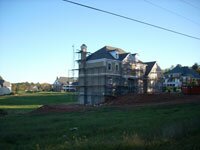NEWS- Slumpsville: If you build it, will they come?

Buyers continue to snap up million-dollar houses, such as these at the former Cricket Hill Farm near Ivy, but some builders are hurting.
PHOTO BY HAWES SPENCER
Pssst. Hey, you! Wanna buy a new house?
If you hear someone whispering such an offer from a side street or back alley while reaching out to twist your arm, it could be any one of the dozens of local builders carrying a hefty inventory of new homes. Many houses conceived in a sizzling hot seller's market suddenly find themselves chilling among more than 3,500 residential listings cluttering area listings and causing some homebuilder heartburn.
Okay, so maybe builders haven't quite sunk to back-alley deals or coercion tactics, but unloading inventory in a strong buyer's market has many of them resorting to techniques not seen in the last half dozen years: slashing prices, offering incentives, even converting for-sale to for-lease. How bad is it?
"Our revenues are down 50 percent from last year," says Mike Gaffney, president of Gaffney Homes. "Every builder in the market, maybe every builder in the country, has cut staff and lowered prices."
Still, Gaffney insists that he knows of no local builders on the verge of going under. Rather, they– like he– are looking for ways to stay alive, he says, and to cover their bottom lines.
Gaffney says the need to sell the houses quickly has led to deep discounts. In Huntley, a new development off Stribling Avenue, Gaffney has lowered prices on houses by $80,000– from $549,000 to $469,000. Those houses, he points out, feature upgrades like granite countertops, stainless appliances, and cherry cabinets– things he likely won't include when starting new construction in the current market.
Still, even such discounts haven't led to rapid sales, and he believes that's because people have tuned in to national news predicting ongoing doom and gloom in the housing market.
"It's almost like a paralysis with people that they don't want to buy," he says.
In response to such fears, Gaffney says he's offering lease-purchase options, in which a buyer can defer purchase for a period of time– a compromise that helps the builder cover costs and gives buyers time to consider.
Church Hill Homes is another area builder feeling the pinch of the slowing market and inventory glut.
"We have reduced staff a little," admits Greg Slater, director of sales and marketing. "We were also geared up to build 80 homes a year, and we realized that's not going to happen." He predicts a number in the "50 range."
Slater says Church Hill saw tremendous success with its Village Place development off Cherry Avenue– only one of the 24 half-million dollar houses is still for sale. But Church Hill's newer Carter's View, off Old Ridge Street, isn't selling so quickly despite glorious 270-degree mountain views.
But Belvedere, a planned 700-unit development off Rio Road that was the subject of a recent dispute over burning debris, is generating buyer interest, says Slater.
"We're bullish on Belvedere; we're making sales, being more competitive than we've ever been," he says. "We've lowered prices to make things happen."
While the big companies are suffering under glacial sales and slumping prices, a smaller local builder says he hasn't felt much pressure yet.
"I'm looking good," says Mike Sadler, president of Jefferson Area Builders. "I have potential contracts that should come to fruition that will keep me set through 2008."
Sadler, who recently built a house for a Hook staffer, attributes his comfortable position to his 30-year longevity as a builder and to his conservative nature, which allowed him to resist rapid growth during the soaring market of the last five years. He says he employs just 10 full-timers to build about around 20 houses each year and keeps his annual sales around $5 million.
"I'm responsible for the people I employ," says Sadler, recalling advice he received during other tough times. "If you don't have to lay off, don't. It's hard to find good people and keep them."
Sadler says today's overbuilding woes pale beside the toughest time he's seen, circa 1980, when interest rates soared to 21 percent, spelling doom for many local builders.
"No one can borrow money at that point," he says. Still, surviving the experience was valuable.
"You kind of build up a resistance to those things," he says. "You don't forget those times."
What does the future hold for builders? And should buyers really take builders' potentially conflicted advice to purchase now?
Mortgage broker Bob Crist thinks so.
"Five years ago, if you wanted to buy a house, you'd put in a contract and then find out the house had three other contracts," he says. Now, he points out, there's bulging inventory with rates still historically low at 6.125 at press time for a 30-year fixed mortgage. "Yeah, it's a real good time to buy a house," Crist says.
Sadler admits he can't see the future, but he predicts the slow market will last until 2009, then pick up. And he says anyone complaining about the slowdown should stop.
"The correction was much needed because there was too much building going on. It needed to slow down to let buyers catch up," he says. "It isn't like in the '80s where interest rates went up. This is a soft landing."
#